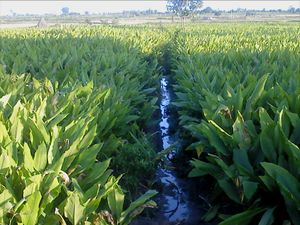Note: This is a project under development. The articles on this wiki are just being initiated and broadly incomplete. You can Help creating new pages.
Difference between revisions of "Curcuma longa - Haridra"
| Line 1: | Line 1: | ||
[[File:Turmeric.JPG|thumb|right|''Turmeric'', ''Haladi'', ''Curcuma longa'']] | [[File:Turmeric.JPG|thumb|right|''Turmeric'', ''Haladi'', ''Curcuma longa'']] | ||
| − | '''Turmeric''' | + | '''Turmeric''' is a rhizomatous herbaceous perennial plant of the ginger family Zingiberaceae. It is native to southern Asia, requiring temperatures between 20 and 30 °C and a considerable amount of annual rainfall to thrive. |
| − | |||
| − | |||
==Uses== | ==Uses== | ||
Revision as of 17:59, 15 May 2018
Turmeric is a rhizomatous herbaceous perennial plant of the ginger family Zingiberaceae. It is native to southern Asia, requiring temperatures between 20 and 30 °C and a considerable amount of annual rainfall to thrive.
Contents
- 1 Uses
- 2 Parts Used
- 3 Chemical Composition
- 4 Common names
- 5 Properties
- 6 Habit
- 7 Identification
- 8 List of Ayurvedic medicine in which the herb is used
- 9 Where to get the saplings
- 10 Mode of Propagation
- 11 How to plant/cultivate
- 12 Commonly seen growing in areas
- 13 Photo Gallery
- 14 References
- 15 External Links
Uses
Wounds, Cuts, Snakebites, Curing liver disorders, Skin eruptions, Blotches, Pimples, Diarrhea, Sore throats[1]
Parts Used
Chemical Composition
The rhizomes contain curcuminoids, curcumin, cyclocurcumin, bisdemethoxycurcumin[2]
Common names
| Language | Common name |
|---|---|
| Kannada | |
| Hindi | |
| Malayalam | |
| Tamil | |
| Telugu | |
| Marathi | NA |
| Gujarathi | NA |
| Punjabi | NA |
| Kashmiri | NA |
| Sanskrit | |
| English | Agrimony |
Properties
Reference: Dravya - Substance, Rasa - Taste, Guna - Qualities, Veerya - Potency, Vipaka - Post-digesion effect, Karma - Pharmacological activity, Prabhava - Therepeutics.
Dravya
Rasa
Guna
Veerya
Vipaka
Karma
Prabhava
Habit
Identification
Leaf
| Kind | Shape | Feature |
|---|---|---|
| Simple | alternate | The leaves are divided into 3-6 toothed leaflets, with smaller leaflets in between |
Flower
| Type | Size | Color and composition | Stamen | More information |
|---|---|---|---|---|
| Unisexual | 2-4cm long | yellow, pink or orange | 5 | Flowering may occur early in the growing season |
Fruit
| Type | Size | Mass | Appearance | Seeds | More information |
|---|---|---|---|---|---|
| simple | 7–10 mm | fruiting time is June and July | many | {{{6}}} |
Other features
List of Ayurvedic medicine in which the herb is used
- Vishatinduka Taila as root juice extract
Where to get the saplings
Mode of Propagation
How to plant/cultivate
While preparing the nursery for turmeric production, at the same time we cultivate a green manure crop (Daincha) inthe main field[4]
Commonly seen growing in areas
Tall grasslands, meadows, Borders of forests and fields.
Photo Gallery
References
- ↑ Cite error: Invalid
<ref>tag; no text was provided for refs namedUses - ↑ "Chemical constituents"
- ↑ "Curcuma Morphology"
- ↑ "CULTIVATION PRACTICES "
External Links
- Pages with reference errors
- Ayurvedic Herbs known to be helpful to treat Wounds
- Ayurvedic Herbs known to be helpful to treat Cuts
- Ayurvedic Herbs known to be helpful to treat Snakebites
- Ayurvedic Herbs known to be helpful to treat Curing liver disorders
- Ayurvedic Herbs known to be helpful to treat Skin eruptions
- Ayurvedic Herbs known to be helpful to treat Blotches
- Ayurvedic Herbs known to be helpful to treat Pimples
- Ayurvedic Herbs known to be helpful to treat Diarrhea
- Ayurvedic Herbs known to be helpful to treat Sore throats
- Herbs with Dried Folaige used in medicine
- Herbs with Whole herb used in medicine
- Herbs with common name in English
- Habit - Herb
- Index of Plants which can be propagated by Seeds
- Index of Plants which can be propagated by Cuttings
- Herbs that are commonly seen in the region of Tall grasslands
- Herbs that are commonly seen in the region of meadows
- Herbs that are commonly seen in the region of Borders of forests and fields
- Herbs



